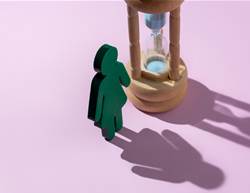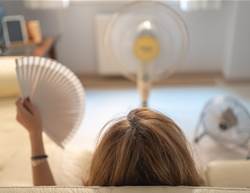Maybe you accidentally did a wee when you had a fit of giggles, or maybe you’ve woken up for the fourth time tonight with an urgent need to go to the toilet. What’s going on? After all, our bladder is something you’ve had under control ever since you came out of nappies.
And yet the facts show that one in three women has some form of bladder issues, also known as incontinence. What’s more, these can become a growing problem as we head through our 40s, 50s and beyond.
“There’s a lot of reasons for this,” explains women’s health physiotherapist Caitlin Dunsford. Common causes, she says, include chronic constipation, chronic coughing, lifestyle diseases like type 2 diabetes and some forms of medication. “But the biggest trigger for urinary incontinence in midlife is changes in oestrogen production,” she says.
Oestrogen plays an important role in keeping our muscles healthy and strong, so as your oestrogen levels decline during menopause your muscle tone may decline, and this includes the muscles in the bladder.
“It's going to affect how easily your bladder can stretch and collect and store urine until you're ready to go to the toilet.”
There are different types of incontinence, but two of the most common are urge incontinence (sudden urge to go) and stress incontinence (leaking during activities like coughing or lifting.
Here are several common and surprising causes of incontinence and what you can do about them.
1. Fix constipation
“A full bowel is going to massively impact how likely you are to leak when you cough, sneeze and laugh or how urgently you feel the need to pass urine,” says Dunsford.
“One of the first things you can do to help improve your bladder health is to improve your bowel health first. I would be wanting you to do a poo every day, and it should be easy to pass soft and squishy like a banana. And you should be able to empty your bowels and feel completely empty within five minutes of sitting down onto the toilet.”
Slowly adding more fibre to your diet (not all at once or you risk bloating) and/or taking an over-the-counter stool softener can help, she says.
2. Get hydrated
It sounds counterintuitive, but the urge to urinate frequently may be because you’re not drinking enough.
“The bladder requires a certain amount of stretch on it to be able to empty completely. And so if you are chronically under-hydrated it can actually make it harder for the bladder to completely empty, you have this small amount left in the bladder, which is then going to trigger your urgency again, and you end up in this vicious cycle.”
3. Do pelvic floor exercises the RIGHT way
“A lot of women come to me saying, ‘I've tried pelvic floor exercises and they didn't work. They’ve been told, ‘You can do it sitting in the car at the traffic light, you could do it when you're making a cup of tea, you know, it's that easy’, but the truth is pelvic floor exercises are hard. They require a lot of mental imagery and motor control and planning.”
Good pelvic floor muscle training should do should target strength, length, and coordination. So it's more than just squeezing that muscle on. And then if we're going to train it in a way that builds muscle change, that happens through sets and reps just like you would if you were doing squats and going to the gym.
“Ideally, a healthy pelvic floor should be able to squeeze for 30 seconds without fatiguing. But anywhere between 10 and 30 seconds is quite good. A really good holistic pelvic floor muscle training program should have a combination of longer holds around 10 to 30 seconds, but also quick squeezes because you also need that muscle to quickly and strongly turn on if you're about to sneeze.
“A holistic pelvic floor muscle training programme would look at exercises that manipulate time and intensity of the squeeze.”
Learn how to do pelvic floor exercises.
What to do about it
Although many of us experience bladder problems, we don’t like to talk about. A study of more than 1,000 women by Poise said that more than three in five (61%) have not spoken with a GP or health professional and nearly half (46%) have never discussed it with their family or friends.
Media personality Fiona Falkiner, says: “I am one of the thousands of Australian women who would NEVER speak about bladder leakage. Experiencing bladder leakage has made me feel ashamed and let down by my body. It’s something I was too scared to talk to anyone about. But that stops now.”
It’s worth the awkward conversation. Incontinence can often be prevented, better managed and even cured. Talk to your doctor or call the National Continence Helpline on 1800 33 00 66.
To learn more about bladder leakage, listen to physiotherapist Caitlin Dunsford’s expert advice in our podcast Thriving in Menopause.









.png&h=193&w=250&c=1&s=1)
.png&h=193&w=250&c=1&s=1)

